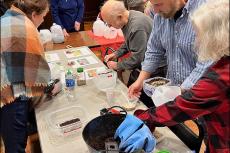The last 15 years have seen an almost 300-percent increase in the linear feet of bulkheads in East Hampton Town, a 600-percent increase in the linear feet of docks, and a significant increase in rock revetments in the same span, the town trustees were told last week.
Joyce Novak, executive director of the Peconic Estuary Partnership, told the trustees that the statistics come from the group’s hardened shoreline assessment, first conducted in 2001 and updated in 2019. Docks, piers, breakwaters, groins, revetments, bulkheads, and jetties were surveyed.
The partnership’s 2003 report, using aerial imagery from 2001, showed 16,279 linear feet of bulkhead. Its 2019 report, using 2016 aerial imagery, revealed 45,264 linear feet. Docks went from 5,840 linear feet to an estimated 30,000 linear feet, though that figure is still under review. According to the partnership’s surveys, revetments climbed from 1,030 to 13,861 linear feet, and groins from 1,312 to 9,482 linear feet.
“It’s quite obvious that revetments are extensive in this area, along with groins,” Ms. Novak said.
It has been demonstrated that hard structures like bulkheads, revetments, and groins, installed to counteract erosion, have the unintended consequence of accelerating erosion of adjacent shorelines. A domino effect typically follows, with adjacent property owners following suit. “If there are no adjacent bulkheads, putting one in will eventually force the others to be bulkheaded,” Ms. Novak said.
The extent of the increase in hardened shorelines “tells us we are running out of natural shorelines quite quickly,” she said, with implications beyond coastal flooding and lost beaches, wetlands, and eelgrass beds. Horseshoe crabs, which the partnership studies, need soft, sandy beaches for habitat. This habitat, she said, is “disappearing rapidly in the Peconics.”
The partnership has set up a demonstration “living shoreline” project in Southold in cooperation with that town, Suffolk County, and Cornell Cooperative Extension. Where “wave energy is reflected by hardened shorelines, leading to further shoreline destabilization,” living shorelines “absorb and dissipate wave energy and allow for natural water and sand movement patterns,” according to the partnership. These “soft” solutions are designed to mimic the natural environment, using native plants, shellfish, and other natural features such as rocks, sand, wood, coconut fiber, and shells to stabilize and protect coasts and decrease direct wave energy.
Ms. Novak said the partnership will organize a tour of the demonstration project for the trustees in the spring.
“It seems we come across homeowners who are torn if they should go with a permanent bulkhead structure or something more environmentally friendly,” said Ben Dollinger of the trustees, “but they are so concerned about their home and safety that it’s an emotional decision. If we had more information for them to make an informed decision . . . this could be very helpful.”
“It is emotional,” Ms. Novak agreed. “It’s very difficult.” While “there are areas where natural solutions will not be enough,” she said that “we need to understand where those are, and where we have the ability to encourage people to keep it natural.”
The trustees agreed last fall to enact a moratorium on the construction of docks and floating structures in all waters under their jurisdiction while they develop a policy on same, shortly after a split vote to allow an 80-foot dock in Three Mile Harbor. That vote was divisive and marked by a rare degree of disagreement within the board.
“We’re trying to inventory all our dock structures in our water bodies,” Jim Grimes told Ms. Novak. The partnership’s data on structures “could be of huge use for us” in the trustees’ inventory and development of a long-range policy on docks and structures, he said. “Part of that is we need to know what’s out there.”
Ms. Novak said she would make the data available to the trustees.
The Peconic Estuary is one of 28 estuaries designated by the federal Environmental Protection Agency as an estuary of national significance. The Peconic Estuary Partnership is part of the National Estuary Program, which was established to protect and restore nationally significant estuaries threatened or impaired by pollution, development, and overuse.



